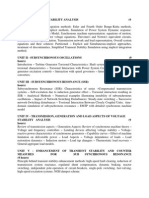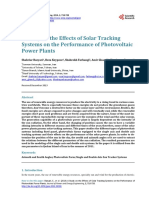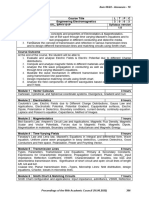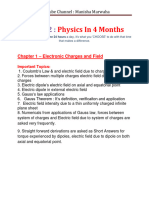Wind and Solar Pyq Aku
Wind and Solar Pyq Aku
Uploaded by
nios 12thCopyright:
Available Formats
Wind and Solar Pyq Aku
Wind and Solar Pyq Aku
Uploaded by
nios 12thOriginal Description:
Original Title
Copyright
Available Formats
Share this document
Did you find this document useful?
Is this content inappropriate?
Copyright:
Available Formats
Wind and Solar Pyq Aku
Wind and Solar Pyq Aku
Uploaded by
nios 12thCopyright:
Available Formats
Wind and Solar Energy Systems 3L:0T:0P 3 credits
Course Outcomes:
At the end of this course, students will demonstrate the ability to
Understand the energy scenario and the consequent growth of the power generation from
renewable energy sources.
Understand the basic physics of wind and solar power generation.
Understand the power electronic interfaces for wind and solar generation.
Understand the issues related to the grid-integration of solar and wind energy systems.
Module 1: Physics of Wind Power: (5 Hours)
History of wind power, Indian and Global statistics, Wind physics, Betz limit, Tip speed ratio,
stall and pitch control, Wind speed statistics-probability distributions, Wind speed and power-
cumulative distribution functions.
Module 2: Wind generator topologies: (12 Hours)
Review of modern wind turbine technologies, Fixed and Variable speed wind turbines, Induction
Generators, Doubly-Fed Induction Generators and their characteristics, Permanent-Magnet
Synchronous Generators, Power electronics converters. Generator-Converter configurations,
Converter Control.
Module 3: The Solar Resource: (3 Hours)
Introduction, solar radiation spectra, solar geometry, Earth Sun angles, observer Sun angles, solar
day length, Estimation of solar energy availability.
Module 4: Solar photovoltaic: (8 Hours)
Technologies-Amorphous, mono crystalline, polycrystalline; V-I characteristics of a PV cell, PV
module, array, Power Electronic Converters for Solar Systems, Maximum Power Point Tracking
(MPPT) algorithms. Converter Control.
Module 5: Network Integration Issues: (8 Hours)
Overview of grid code technical requirements. Fault ride-through for wind farms - real and
reactive power regulation, voltage and frequency operating limits, solar PV and wind farm
behavior during grid disturbances. Power quality issues. Power system interconnection
experiences in the world. Hybrid and isolated operations of solar PV and wind systems.
Module 6: Solar thermal power generation: (3 Hours)
Technologies, Parabolic trough, central receivers, parabolic dish, Fresnel, solar pond, elementary
analysis.
Text / References:
1. T. Ackermann, “Wind Power in Power Systems”, John Wiley and Sons Ltd., 2005.
2. G. M. Masters, “Renewable and Efficient Electric Power Systems”, John Wiley and Sons,
2004.
3. S. P. Sukhatme, “Solar Energy: Principles of Thermal Collection and Storage”, McGraw
Hill, 1984.
4. H. Siegfried and R. Waddington, “Grid integration of wind energy conversion systems”
John Wiley and Sons Ltd. 2006.
5. G. N. Tiwari and M. K. Ghosal, “Renewable Energy Applications”, Narosa Publications,
2004.
6. J. A. Duffie and W. A. Beckman, “Solar Engineering of Thermal Processes”, John Wiley
& Sons, 1991.
You might also like
- Gujarat Technological University: W.E.F. AY 2018-19No ratings yetGujarat Technological University: W.E.F. AY 2018-193 pages
- Rajasthan Technical University, Kota: 7 L+0T+0P SN Hours 1 1 2 Physics of Wind Power 5No ratings yetRajasthan Technical University, Kota: 7 L+0T+0P SN Hours 1 1 2 Physics of Wind Power 51 page
- IV-i Solar & Wind Electrical Systems Digital Notes 1No ratings yetIV-i Solar & Wind Electrical Systems Digital Notes 1167 pages
- BE Electrical Engineering Syllabus Final Draft As On 13 FebNo ratings yetBE Electrical Engineering Syllabus Final Draft As On 13 Feb37 pages
- Course-2 Advanced Power Electronics for Renewable SourcesNo ratings yetCourse-2 Advanced Power Electronics for Renewable Sources2 pages
- Eee4003 Generation and Utilization of Electrical Energy Eth 1.0 37 Eee4003No ratings yetEee4003 Generation and Utilization of Electrical Energy Eth 1.0 37 Eee40032 pages
- A Survey of Micro-Actuator Technologies For Future Spacecraft MissionsNo ratings yetA Survey of Micro-Actuator Technologies For Future Spacecraft Missions11 pages
- A Study On The Effects of Solar Tracking Systems On The Performance of Photovoltaic Power PlantsNo ratings yetA Study On The Effects of Solar Tracking Systems On The Performance of Photovoltaic Power Plants11 pages
- Electromagnetics - TH - 1.0 - 71 - Bece205l - 66 AcpNo ratings yetElectromagnetics - TH - 1.0 - 71 - Bece205l - 66 Acp2 pages
- 2009 - IEEE - Comprehensive Approach To Modeling and Simulation of PV ArraysNo ratings yet2009 - IEEE - Comprehensive Approach To Modeling and Simulation of PV Arrays12 pages
- CHAP 1, Lecture 1-A Fundamental's of Power SystemNo ratings yetCHAP 1, Lecture 1-A Fundamental's of Power System43 pages
- Understand The Various Power System Components. Evaluate Fault Currents For Different Types of FaultsNo ratings yetUnderstand The Various Power System Components. Evaluate Fault Currents For Different Types of Faults4 pages
- Final Report Fuzzy Logic Based Mamimum Power Point Tracking For Solar PV ArrayNo ratings yetFinal Report Fuzzy Logic Based Mamimum Power Point Tracking For Solar PV Array7 pages
- Power System Control and Automation Syllabus100% (1)Power System Control and Automation Syllabus23 pages
- Maulana Abul Kalam Azad University of Technology, West Bengal Syllabus For B. Tech in Electrical EngineeringNo ratings yetMaulana Abul Kalam Azad University of Technology, West Bengal Syllabus For B. Tech in Electrical Engineering29 pages
- Detailed Syllabus: M. Tech. (Renewable Energy) R.16No ratings yetDetailed Syllabus: M. Tech. (Renewable Energy) R.1652 pages
- Electrical Machine-II: Course Contents (Uec Scheme)No ratings yetElectrical Machine-II: Course Contents (Uec Scheme)6 pages
- Photovoltaics | 101: The hands-on beginner's guide for designing an on-grid or off-grid (stand-alone) PV system with battery storage for your home, RV,...From EverandPhotovoltaics | 101: The hands-on beginner's guide for designing an on-grid or off-grid (stand-alone) PV system with battery storage for your home, RV,...No ratings yet
- INSTALL YOUR OWN Photovoltaic System: Hybrid, Stand Alone and Battery StorageFrom EverandINSTALL YOUR OWN Photovoltaic System: Hybrid, Stand Alone and Battery StorageNo ratings yet
- Off Grid Solar Power: The Ultimate Step by Step Guide to Install Solar Energy Systems. Cut Down on Expensive Bills and Make Your House Completely Self-SustainableFrom EverandOff Grid Solar Power: The Ultimate Step by Step Guide to Install Solar Energy Systems. Cut Down on Expensive Bills and Make Your House Completely Self-SustainableNo ratings yet
- Student Book Answers Paper 1 Questions: Answers Extra Information MarkNo ratings yetStudent Book Answers Paper 1 Questions: Answers Extra Information Mark5 pages
- Akshay Prakash - Technical Seminar-FINAL-1No ratings yetAkshay Prakash - Technical Seminar-FINAL-128 pages
- Part 1. Choose The Correct Answer (A, B, C or D) in Each Sentence. (1.0 PT)No ratings yetPart 1. Choose The Correct Answer (A, B, C or D) in Each Sentence. (1.0 PT)5 pages
- Biochemical Methane Potential of Different Organic Wastes and Energy Crops From EstoniaNo ratings yetBiochemical Methane Potential of Different Organic Wastes and Energy Crops From Estonia12 pages
- 0088-PV-M-VDC-005 Drawings of Cable Bracket-1-Rev01 (Cat-1)No ratings yet0088-PV-M-VDC-005 Drawings of Cable Bracket-1-Rev01 (Cat-1)2 pages
- SolarQuarter December Issue 2018 Final Print-CompressedNo ratings yetSolarQuarter December Issue 2018 Final Print-Compressed44 pages
- A Review On Biomass As A Fuel For BoilerNo ratings yetA Review On Biomass As A Fuel For Boiler28 pages
- RAJESH DAS at MECHANICAL at 4TH YEAR at RENEWABLE ENERGYNo ratings yetRAJESH DAS at MECHANICAL at 4TH YEAR at RENEWABLE ENERGY29 pages
- List of GEDA Empaneled 291 Vendors Category 9No ratings yetList of GEDA Empaneled 291 Vendors Category 92 pages
- 2020 lozano et al GIS based modelink of residual biomass availability for energy and production in Mexico (2)No ratings yet2020 lozano et al GIS based modelink of residual biomass availability for energy and production in Mexico (2)16 pages
- International Switch Energy: Case CompetitionNo ratings yetInternational Switch Energy: Case Competition19 pages
- Roland Berger Trend Compendium 2030: Megatrend 3No ratings yetRoland Berger Trend Compendium 2030: Megatrend 345 pages
- Opportunities in Wind Power Projects in ArgentinaNo ratings yetOpportunities in Wind Power Projects in Argentina1 page
- Hilda Mulock, Deloitte Oil and Gas ExpertNo ratings yetHilda Mulock, Deloitte Oil and Gas Expert4 pages
- 2022 - GIZ - Research On Electric Buses in ChinaNo ratings yet2022 - GIZ - Research On Electric Buses in China84 pages
- MCQ On Renewable Energy Resources (ROE086) TIME-30 Min100% (1)MCQ On Renewable Energy Resources (ROE086) TIME-30 Min4 pages
























































































